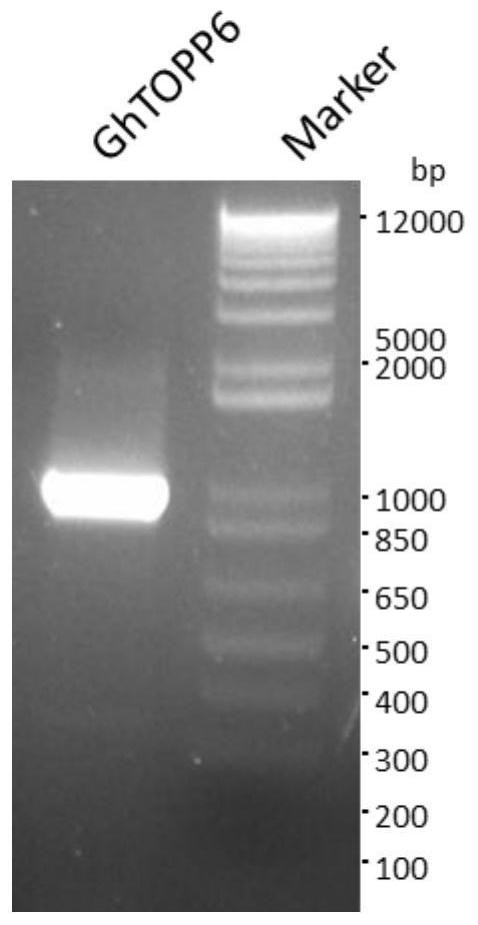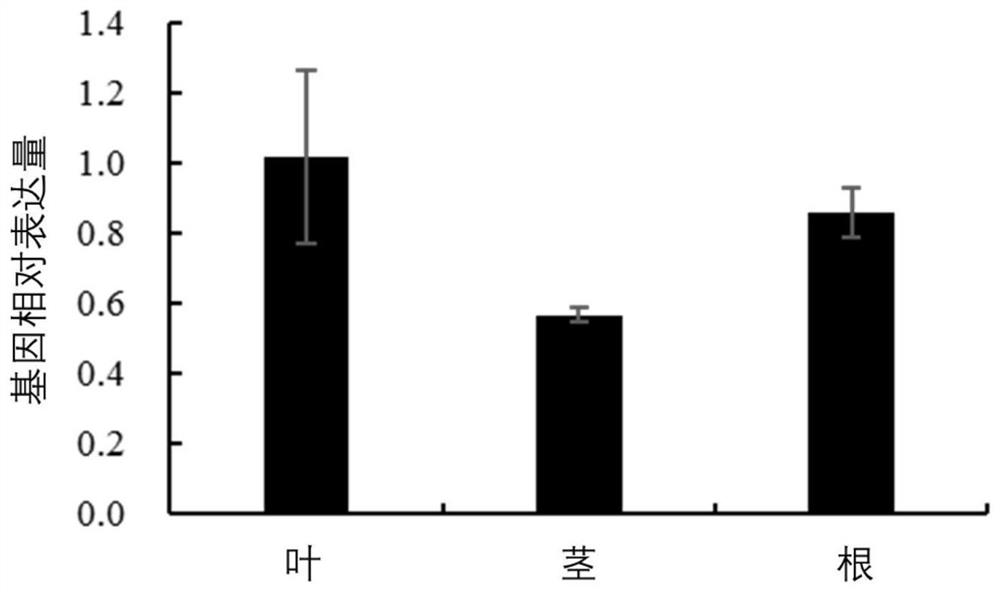Gossypium hirsutum serine/threonine protein phosphatase GhTOPP6 as well as coding gene and application thereof
A gene and protein technology, applied in the field of cotton silk/threonine protein phosphatase GhTOPP6 and its coding gene and application, can solve the problems that there are no research reports on PP1 members
- Summary
- Abstract
- Description
- Claims
- Application Information
AI Technical Summary
Problems solved by technology
Method used
Image
Examples
Embodiment 1
[0079] Example 1. Discovery, cloning and localization of GhTOPP6 protein and its coding gene
[0080] 1. Discovery of GhTOPP6 protein and its coding gene
[0081] Screening of salt-related genes in the VIGS cDNA library (using VIGS technology to study the function of cotton stress resistance genes, Li Fangjun, "China Agricultural University", 2014), using the cotton database to search from the cotton variety "Guoxin 3" (Guoxin 3 Insect-resistant cotton cultivation technology, Feng Sulian, "Hebei Agriculture", 2011, 06) obtained a new protein and named it GhTOPP6 protein. The amino acid sequence of the GhTOPP6 protein is shown in SEQ ID No.1, consisting of 323 Composition of amino acid residues; the gene encoding the GhTOPP6 protein is named GhTOPP6 gene, and the open reading frame of the GhTOPP6 gene is shown in SEQ ID No.2, consisting of 972 nucleotides.
[0082] 2. Cloning of GhTOPP6 gene
[0083] Cotton leaf and root RNA was extracted using the Aidelai kit (the kit was pu...
Embodiment 2
[0104] Example 2, VIGS silenced plant stress phenotype
[0105] 1. Construction of VIGS-GhTOPP6 silencing vector
[0106] 1. Extract the total RNA from the leaves of the cotton variety "Guoxin 3" and reverse transcribe it into cDNA.
[0107] 2, with the cDNA that step 1 obtains as template, carry out PCR amplification with the primer pair that F1 and R1 form, obtain PCR amplification product ( Figure 5 ).
[0108] F1: 5'-G GAATTC ATGGAAACTAGGGTTCTT-3' (underlined is the restriction site of EcoRI)
[0109] R1:5'-CG GGATCC AGGAGAAGACATATGGTT-3' (the restriction site of BamHI is underlined)
[0110] 3. The PCR amplification product obtained in step 2 was double-digested with restriction endonucleases EcoRI and BamHI, and the digested product was recovered.
[0111] 4. Use restriction endonucleases EcoRI and BamHI to double digest the pYL156 (pTRV2:RNA2) vector (recorded in the non-patent literature "Gao X, 2013, Functional genomic analysis of cotton genes with agrobacteriu...
Embodiment 3
[0129] Embodiment 3, the acquisition of transgenic plants
[0130] 1. The 35S::GhTOPP6-GFP recombinant vector obtained in Step 4 of Example 1 was introduced into Agrobacterium strain GV3101 to obtain recombinant Agrobacterium.
[0131] 2. The recombinant Agrobacterium obtained in step 1 was shaken in LB liquid medium (50 μg / mL kanamycin, 25 μg / mL gentamycin) for 24 hours at 28° C., centrifuged at 4000 rpm for 10 minutes to collect the recombinant Agrobacterium and resuspended ( Resuspension: 50mM MES pH5.6, 5% sucrose, solvent is water), adjust the concentration of resuspension to OD 600 =0.8, add silwetL-77 (500μl / L, soak the inflorescence of Arabidopsis thaliana with the bacterial suspension, and then wrap the Arabidopsis thaliana with a black plastic bag to keep the humidity. Remove the plastic bag, restore the light, cultivate the plants according to the conventional method until they are firm, and harvest mature T. 0 generation seeds.
[0132] 3. Cultivate T in 1 / 2MS m...
PUM
 Login to View More
Login to View More Abstract
Description
Claims
Application Information
 Login to View More
Login to View More - R&D
- Intellectual Property
- Life Sciences
- Materials
- Tech Scout
- Unparalleled Data Quality
- Higher Quality Content
- 60% Fewer Hallucinations
Browse by: Latest US Patents, China's latest patents, Technical Efficacy Thesaurus, Application Domain, Technology Topic, Popular Technical Reports.
© 2025 PatSnap. All rights reserved.Legal|Privacy policy|Modern Slavery Act Transparency Statement|Sitemap|About US| Contact US: help@patsnap.com



